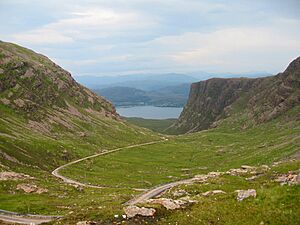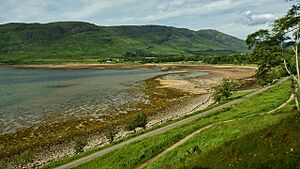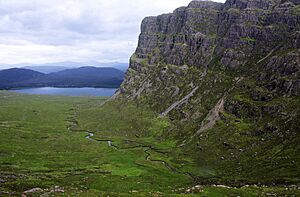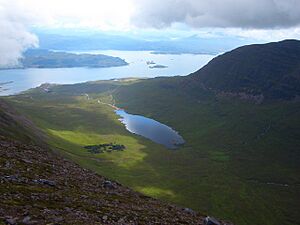Applecross facts for kids
Quick facts for kids Applecross
|
|
|---|---|
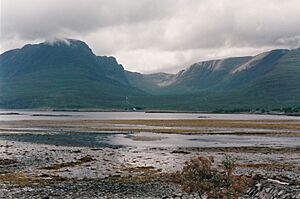 View across Loch Kishorn to the Applecross peninsula |
|
| Population | 544 |
| OS grid reference | NG714444 |
| Council area | |
| Country | Scotland |
| Sovereign state | United Kingdom |
| Post town | STRATHCARRON |
| Postcode district | IV54 |
| Police | Northern |
| Fire | Highlands and Islands |
| Ambulance | Scottish |
| EU Parliament | Scotland |
| UK Parliament |
|
| Scottish Parliament |
|
Applecross (called A' Chomraich in Scottish Gaelic, meaning 'The Sanctuary') is a beautiful peninsula in Wester Ross, located in the Scottish Highlands. It's surrounded by water and mountains. To the south is Loch Kishorn, to the north is Loch Torridon, and to the east is Glen Shieldaig. On its western side, you'll find Applecross Bay and the Inner Sound.
This area is very mountainous and doesn't have many people living there. It's connected to the rest of the mainland by two small roads. A very old monastery was started here by Saint Máel Ruba way back in the 7th century. Today, only a special carved stone remains from that time.
Contents
Exploring Applecross: Geography and Roads
Applecross used to be extremely cut off from the rest of Scotland. For a long time, the only way to get there was by boat. Later, a road was built, but it was one of Scotland's most famous and difficult roads. This road is called Bealach na Ba, which means 'Pass of the Cattle'. It crosses the peninsula and goes up to a height of 626 meters (about 2,054 feet). This is just below the 792-meter (about 2,598 feet) high mountain called Sgùrr a' Chaorachain.
In 1975, a new winding coastal road was built. This road goes around the edge of the peninsula to Shieldaig and Torridon. It follows the shore of the Inner Sound and Loch Torridon.
The group of houses often marked as 'Applecross' on maps is actually called 'Shore Street'. Locals just call it 'The Street'. The name Applecross actually refers to the whole peninsula. This includes smaller villages like Toscaig, Culduie, Camusterrach, and Sand. Applecross is also the name of a large estate and a civil parish. This larger area includes Shieldaig and Torridon, and it has a population of 544 people. A small river, the River Applecross (called Abhainn Crosain in Gaelic), flows into the bay at Applecross.
A Look Back: Applecross History
The name Applecross comes from an old Pictish word, Aporcrosan. This means 'where the river Crossan meets another water body'. In modern Gaelic, it's Obar Crosain.
Applecross has a strong connection to Saint Máel Ruba. He came to Scotland in 671 from a big Irish monastery. In 672, he started the monastery of Aporcrosan in what was then Pictish land. He was the first leader of this monastery. The early monastery was located where the local church stands today. You can still see a large, unfinished cross-slab in the churchyard. There are also three beautifully carved pieces of another cross inside the church. These are all clues about the old monastery.
The area around the monastery was known as A’ Chomraich in Gaelic. This means 'the sanctuary'. Its borders were once marked by crosses. Part of one cross, which was destroyed in 1870, can still be seen among farm buildings at Camusterrach.
Over the centuries, the land of Applecross changed hands many times. In the 16th century, it came into the possession of the Mackenzie family. After a brief time when the family lost the land because of their part in the 1715 Uprising, it stayed with the Mackenzies until the mid-19th century.
Today, the Applecross estate is owned by the Applecross Trust. This is a Scottish charity. Their main goal is to protect the special nature of the Applecross peninsula. They want to keep it wild and beautiful, while also managing it in a responsible way.
Amazing Wildlife in Applecross
Applecross is home to many incredible Scottish animals. You might spot large red deer or smaller creatures like pine martens and otters. There are also water voles, blue hares, and foxes. If you are very lucky, you might even see a rare Scottish wildcat!
Many different birds live here too. These include tawny and barn owls, huge white-tailed and golden eagles, and smaller birds like great spotted woodpeckers and song thrush. You might also see bullfinches, golden plovers, and skylarks. Birds of prey like merlins are also present.
In the waters around Applecross, you can find common seals close to the shore. Further out, there are amazing marine animals like basking sharks, minke whales, porpoises, and bottlenose dolphins. On land, you might also come across adders, which are a type of snake.
Economy: How Applecross Works
In July 2010, Applecross opened the UK's first unmanned petrol station. It cost £40,000 to build. This station uses a credit card reader, so customers can fill up their own cars. The local community company took over the business in 2008 to stop it from closing. Without it, people would have to drive a 36-mile (about 58 km) round trip to Lochcarron to get fuel.
Tourism: Visiting Applecross
Recently, more and more tourists have been visiting Applecross. People come here to enjoy hiking, kayaking, fishing, and cycling. The famous North Coast 500 tourist route passes through Applecross. It crosses the challenging Bealach na Bà pass and then follows the scenic coastal road.
Applecross in Media and Arts
Applecross has appeared in several films and TV shows. It was featured as 'Laxdale' in the 1953 film Laxdale Hall. In this movie, the community protests about the bad condition of their access road.
On television, Applecross was shown as 'Carnochie' in an episode of "Upstairs Downstairs" in 1975. It also appeared in Monty Halls' Great Escape in 2009. An episode of Channel 4's Time Team (series 13, episode 13) also visited Applecross to dig up an ancient structure called a broch.
The area is also mentioned in books. It's a setting in Graeme Macrae Burnet's 2015 novel His Bloody Project, which was nominated for a big literary award. It was also the main setting for the "Enchanted Emporium" book series by Pierdomenico Baccalario.



